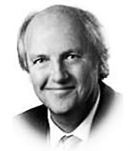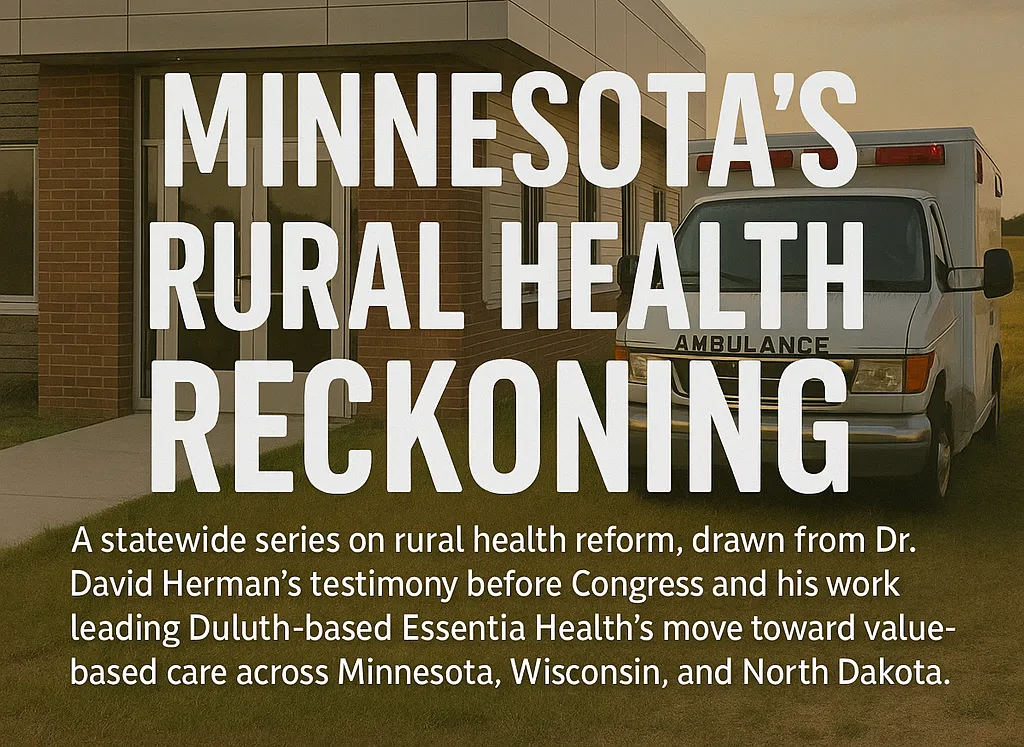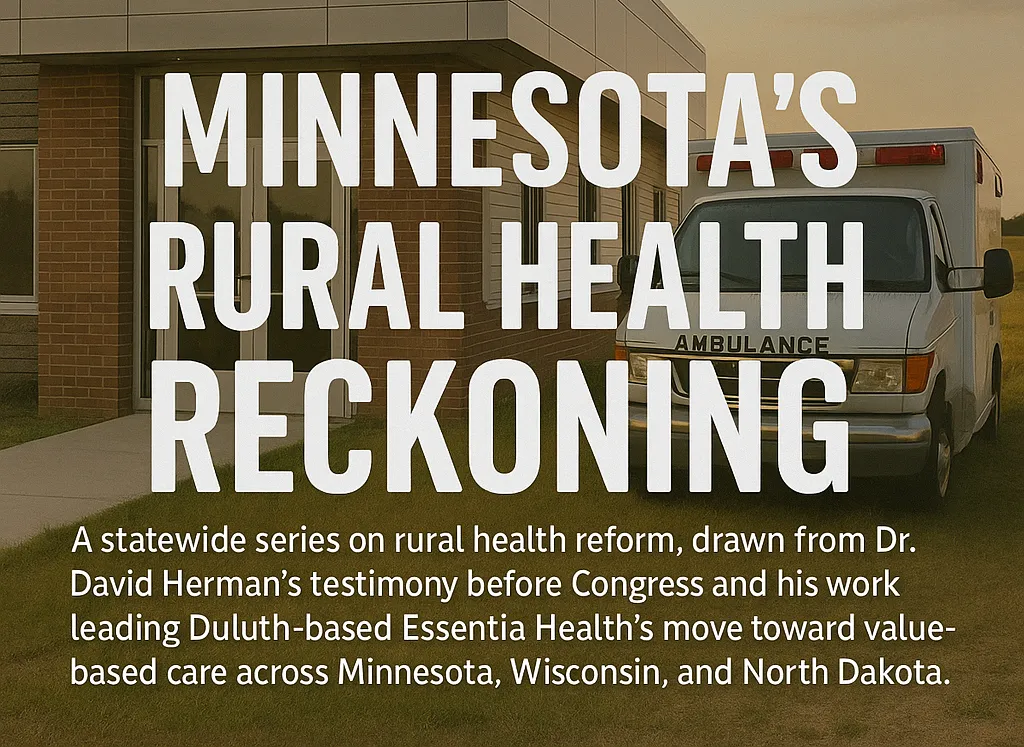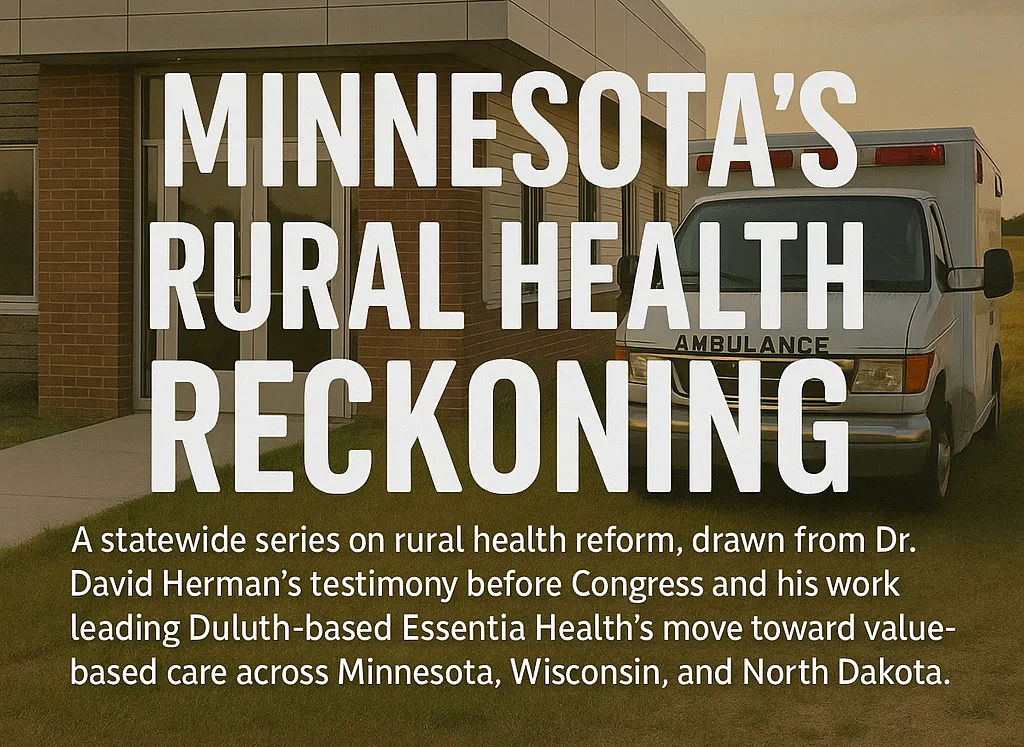
Howie's column is powered by Lyric Kitchen · Bar
North of Hinckley, the map of Minnesota changes shape. Towns thin out, fields widen, and the hospital — often a low brick building by the highway — becomes the most powerful structure for fifty miles in any direction. It is the last major employer that never left.
When the mine closed, when the feed mill went silent, when the grocery cut back to weekend hours, one payroll still arrived every other Friday. The hospital’s lights stayed on, and with them, so did the town.
Dr. David Herman has built his career on defending those lights. As the chief executive of Essentia Health, he has become one of the nation’s leading voices for a simple idea that too many policymakers forget: hospitals aren’t cost centers; they are cornerstones.
“Rural hospitals and health-care systems significantly impact their local communities, both on health and economic sustainability,” he told Congress. “As anchor institutions, they play critical roles in the economic and social vitality of their communities.”
That truth has been hiding in plain sight. In 2022 alone, Essentia poured roughly $430 million into local economies — wages, construction, community programs, and benefits.
“That money doesn’t just circulate through our system,” Herman said. “It circulates through grocery stores, gas stations, schools, and daycare centers. It supports main street.”
Each paycheck is its own economic stimulus. The nurse who buys a minivan, the maintenance worker who renovates a kitchen, the lab tech paying a mortgage — all feed a fragile loop of prosperity.
“Every dollar we spend locally touches two or three more families before it ever leaves town,” Herman said.
COVID-19 stripped away any illusion that rural health care could run on autopilot. When small hospitals closed, families drove 80 miles for care — and stopped returning to shop or dine downtown. The community’s heart migrated with the ambulance.
Herman watched the pattern unfold nationwide and spoke plainly about what he saw.
“You can’t outsource care and expect a community to survive,” he said. “Keeping hospitals solvent is economic development.”
At Essentia, solvency has meant innovation. The system now ties nearly 40 percent of its revenue to measurable health outcomes — the backbone of value-based care. The idea: pay for results, not volume.
“Delivering care through value-based models can be successful in rural communities,” Herman said. “We’ve proven that you can improve quality and lower cost at the same time.”
Between 2018 and 2021, those programs saved Medicare $42 million and Minnesota Medicaid $28 million — concrete proof that reform can work outside metro ZIP codes.
The skyline tells the story. Rising above the harbor is the new St. Mary’s Medical Center, a billion-dollar bet on the future of downtown.
“We’re still betting on this city,” Herman said when the steel first went up. “Because this city bet on us.”
That project did more than reshape Duluth’s horizon; it anchored an entire regional economy. Thousands of construction workers earned paychecks there. Hundreds of permanent staff followed. Restaurants reopened to serve them, and hotel rooms filled again. The hospital became a signal — visible proof that northern Minnesota was not giving up.
Herman calls hospitals “ecosystems,” not enterprises.
“When you invest in health care,” he said, “you invest in everyone who depends on it — which is, in the end, all of us.”
Across the country, data backs him up. The Federal Reserve estimates that hospitals and universities generate $1.7 trillion in economic activity and employ nearly 10 million people. In rural areas, health care supports one in twelve jobs.
When those institutions close, the decline is immediate. Studies show that losing a hospital cuts local income by about 4 percent. Since 2010, more than 140 rural hospitals have shuttered nationwide, leaving behind dark windows and declining tax bases. Herman views those numbers as a warning: “When the ER goes dark, you don’t just lose care — you lose confidence.”
Essentia’s alternative has drawn national attention. Instead of retreating from small towns, it has deepened its roots — in Brainerd, Deer River, Grand Rapids, and dozens of others. Telehealth now links local nurses with Duluth specialists in seconds.
“Rural doesn’t mean remote anymore,” Herman said. “Technology lets us bring world-class care to a patient’s doorstep.”
Recruiting the next generation has been another pillar. Essentia partners with medical schools to train doctors who want to stay rural.
“The future of rural medicine depends on building the next generation of rural doctors,” Herman said. “We have to show them that this isn’t a sacrifice — it’s a calling.”
The approach works because it’s rooted in accountability. “We hold ourselves to the same standards as any large urban system,” Herman said. “But we never forget where our patients live and what they face.”
Even now, the math remains tight. Federal reimbursements lag behind costs. Inflation hits small hospitals hardest. Staffing remains the daily worry. But Herman insists that supporting rural care is among the smartest investments any government can make.
“It’s one of the few areas where every dollar does double duty,” he said. “You improve health, and you strengthen the economy in the same act.”
That argument resonates across political lines. It is pragmatic, measurable, and deeply human — the kind of reasoning that cuts through ideology.
“People may disagree about almost everything else,” Herman said, “but nobody wants to see their hospital close.”
Hospitals, Herman often reminds people, are more than places of healing. They are civic memory — the one institution where every name in town eventually appears, either as patient, parent, or paycheck.
“Our mission isn’t just to deliver care,” he said. “It’s to sustain communities.”
In the end, that’s what makes Essentia’s work matter far beyond Duluth. It is the blueprint for how rural America can endure — not through nostalgia or subsidy, but through stewardship.
“We’ve shown that rural health care can be stable, affordable, and strong,” Herman said. “And when that happens, everything else — schools, businesses, families — has a chance to thrive.”
That is the quiet revolution playing out across the Northland. It’s not driven by slogans or shareholders, but by the simple math of compassion and competence. Every paycheck cut on Friday afternoon, every ambulance ready at midnight, every patient who walks out healthier than they arrived — that’s the economic engine of the North.
And it runs, still, on one truth that never changes: keep the hospital alive, and you keep the town alive — one paycheck, one patient, one heartbeat at a time.





